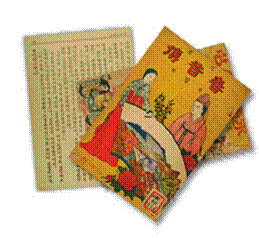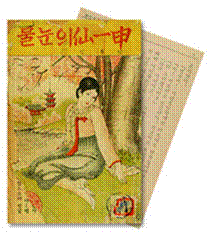Collection
First Paperback Novel in Korean, Ttakjibon

Reading and publishing culture in Korea changed greatly after new printing technology was introduced from the West in the late 19th century. Even though commercial publications and books made with metal type existed before this time, most books were either copied by hand or printed with hand-carved woodblocks. The introduction of the printing press, which used lead movable-type, allowed for the mass production of printed books. These books were called “guhwaljabon” (구활자본) or “sinyeonhwaljabon” (신연활자본), and novels printed with this type were called “guhwaljabon novels” (구활자본 소설).
"Ttakjibon novels” was the nickname for guhwaljabon novels. There are several theories over the origin of the name "ttakjibon”. The most widely accepted theory is that because most guhwaljabon novels had colorful book covers, the name was taken from the word "ttakji" (딱지), which were colorful cards used in a Korean children’s game.
Ttakjibon novels played a crucial role in the popularization and modernization of reading. Tens of thousands of ttakjibon novels were sold every year in the 1920’s and 1930’s, so they became very well-known throughout Korea. The fact that they were so extensively read by the public holds a great deal of historical significance. It’s hard to imagine now, but the illiteracy rate in Korea was very high in the early 20th century as reading culture had not yet taken root. Owning and reading books were simply too expensive for the average person. However, with the mass production and widespread reading of low-priced books, literacy proliferated and the curtain came down on the era when only the privileged classes could own and enjoy books.

There were many different kinds of ttakjibon novels. Some ttakjibon novels were well-known classics such as Hongildong-jeon (홍길동전), Parkssi-jeon (박씨전), Guunmong (구운몽), and Samgukji (삼국지), but others were popular fiction that reflected the trends of the times. Novels like Aegukbuin-jeon (애국부인전), Chiak-san (치악산), and Chuwolsaek (추월색) were products of Korean popular culture of the 1900’s-1910’s, and they opened a new chapter in the history of modern Korean literature. As a part of popular culture, these kinds of ttakjibon novels subtly reflected the state of affairs of contemporary Korean society and culture. Novels like Sinilseon’s Tears (신일선의 눈물) and Kangmyeonghwa-jeon (강명화전) were based on real-life famous persons, while novels like Is This Liquor a Tear or a Sigh? (술은 눈물인가 한숨이런가), A Brave White-Clad Young Man in Manchuria Fields (만주황야 대담한 백의청년), and Flight War (비행전쟁) directly reflected the ground reality of politics and society of 1920’s-30’s Korea. As a result, it can be said that ttakjibon novels encapsulated the popular culture of Korea in the 1920’s-30’s.
Let's go ahead and explore some of these ttakjibon novels.
 This website is the official e-government website of Korea.
This website is the official e-government website of Korea.
